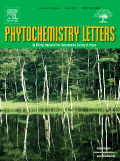
Phytochemistry Letters
Scope & Guideline
Catalyzing scientific excellence in phytochemistry.
Introduction
Aims and Scopes
- Natural Product Isolation and Characterization:
The journal publishes studies that involve the extraction, isolation, and structural elucidation of bioactive compounds from various plant and fungal sources. - Biological Activity Assessment:
Many articles focus on evaluating the biological activities of isolated compounds, including anticancer, anti-inflammatory, antimicrobial, and antioxidant effects. - Phytochemical Research Methodologies:
Phytochemistry Letters emphasizes innovative methodologies such as molecular docking, in vitro assays, and chromatographic techniques for the analysis and quantification of phytochemicals. - Ethnobotanical and Traditional Uses:
The journal includes research that explores the traditional uses of plants in medicine, providing insights into their historical significance and potential modern applications. - Chemistry of Secondary Metabolites:
Research on the chemistry of secondary metabolites, such as alkaloids, terpenoids, flavonoids, and glycosides, is a core aspect of the journal's focus.
Trending and Emerging
- Multi-Target Drug Discovery:
Recent publications increasingly emphasize the identification of compounds that target multiple biological pathways, reflecting a trend towards holistic approaches in drug discovery. - Natural Products in Drug Development:
There is a growing interest in the application of natural products in drug development, particularly in the context of combating diseases such as cancer and viral infections. - Biological Activity Profiling:
Emerging themes include comprehensive biological profiling of phytochemicals, assessing their effects on various cell types and disease models, indicating a shift towards more thorough evaluations. - Sustainable and Eco-Friendly Extraction Techniques:
Research on innovative, environmentally friendly extraction methods for phytochemicals is gaining traction, highlighting a commitment to sustainability in natural product chemistry. - Metabolomics and Chemometrics:
The integration of metabolomic approaches and chemometrics for the analysis of plant secondary metabolites is becoming increasingly popular, allowing for more sophisticated data analysis and interpretation.
Declining or Waning
- Traditional Phytochemistry:
Research focusing solely on the traditional aspects of phytochemistry, such as basic descriptions of plant compounds without biological evaluations, is becoming less common. - Exclusively In Vitro Studies:
There is a noticeable decrease in the publication of studies that only present in vitro findings without further exploration into in vivo models or clinical relevance. - Single Compound Focus:
Research that centers on single isolated compounds without considering their potential synergistic effects with other phytochemicals is gradually declining.
Similar Journals
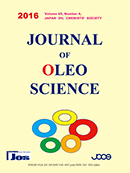
Journal of Oleo Science
Unlocking the Potential of Oleochemicals in Research and IndustryJournal of Oleo Science, published by the Japan Oil Chemists Society, stands as a pivotal resource in the domains of chemical engineering, chemistry, and medicinal applications, with a robust commitment to advancing knowledge in oleochemical research and technology. With an ISSN of 1345-8957 and an E-ISSN of 1347-3352, this open-access journal has been accessible to a global audience since 2021, facilitating the dissemination of high-quality scholarly articles and fostering collaboration among researchers. The journal, which has converged its publication scope from 2001 to 2024, currently holds a respectable Q3 ranking across multiple categories, reflecting its impact in the academic sphere. With Scopus ranks highlighting its position in general chemistry and chemical engineering, the Journal of Oleo Science not only serves as an essential platform for the latest developments in oleo science but also encourages the exploration of innovative approaches to tackling industry challenges. Articles submitted to the journal are subjected to rigorous peer review, ensuring that only the most significant and scholarly work is presented. By championing diverse perspectives and research findings, this journal is an invaluable asset for students, professionals, and academics dedicated to advancing the fields of oleochemistry and beyond.

CHEMISTRY OF NATURAL COMPOUNDS
Transforming Natural Chemistry into Real-World SolutionsChemistry of Natural Compounds is a premier academic journal dedicated to the intersection of natural products and modern chemistry, published by Springer. Since its inception in 1965, this journal has published innovative research articles, reviews, and discussions that focus on the chemistry and biochemistry of natural compounds, with an emphasis on their applications in various fields including medicine, agriculture, and environmental science. Recognized for its contributions to the scientific community, the journal is indexed in key databases and holds a respectable impact factor that underscores its relevance in the academic landscape. Currently ranked in the Q3 category across multiple disciplines, including Biochemistry, Genetics and Molecular Biology, Chemistry, and Plant Science, it serves as a critical resource for researchers and professionals aiming to deepen their understanding of the complex interactions between natural compounds and biological systems. While not an open-access journal, Chemistry of Natural Compounds provides valuable insights and essential findings that can aid in advancing both theoretical and applied sciences for researchers, students, and industry practitioners alike.

PHYTOCHEMISTRY REVIEWS
Advancing Knowledge in Phytochemical SciencePhytochemistry Reviews is an esteemed journal published by Springer, proudly positioned within the top tier of its fields. With an impressive impact factor and recognized as Q1 in both Biotechnology and Plant Science, it serves as a vital resource for scholars and practitioners alike. The journal provides in-depth reviews centered around the chemistry of plant-based compounds, their biological activities, and applications in various industries, thus encompassing a rich inter-disciplinary approach that bridges several areas of scientific inquiry. Since its inception in 2002, Phytochemistry Reviews has become a cornerstone for innovative research, offering comprehensive insights that foster advancements within agricultural, biochemical, and biotechnological realms. Although it is not an open-access publication, the journal remains an essential platform for disseminating high-impact findings, ensuring that professionals, educators, and emerging researchers have access to cutting-edge knowledge that propels the field forward. For those engaged in the ever-evolving world of phytochemistry and related disciplines, Phytochemistry Reviews is a must-read, embodying excellence and scholarly rigor.
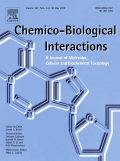
CHEMICO-BIOLOGICAL INTERACTIONS
Bridging Disciplines to Enhance Public SafetyCHEMICO-BIOLOGICAL INTERACTIONS is a premier journal published by Elsevier Ireland Ltd, dedicated to advancing the field of chemical and biological interactions since its inception in 1969. With a robust focus on pharmacology and toxicology, the journal holds a prestigious Q1 ranking in both Medicine (miscellaneous) and Toxicology, reflecting its significance in disseminating influential research. As part of the Scopus database, it ranks #21 out of 133 journals in Toxicology, positioning it in the 84th percentile and ensuring high visibility for cutting-edge studies. This scholarly platform serves as a crucial resource for researchers, professionals, and students who seek reliable and innovative findings at the intersection of chemistry and biology. While currently not open access, CHEMICO-BIOLOGICAL INTERACTIONS provides a comprehensive collection of articles that contribute to the ongoing dialogue in toxin research and its implications on medicinal chemistry, thereby fostering advancements in public health and safety.

Fitoterapia
Bridging Nature and Innovation in Drug DiscoveryFitoterapia is a prestigious journal published by Elsevier that specializes in the fields of drug discovery and pharmacology. Established in 1948 and featuring a comprehensive scope that encompasses all aspects of medicinal plants and their derivatives, this journal is a critical resource for researchers, professionals, and students interested in the pharmacological effects of natural products. With an impressive impact factor reflected in its Q2 ranking in both Drug Discovery and Medicine as well as a Q3 ranking in Pharmacology, Fitoterapia plays a vital role in promoting innovative research in the intersection of traditional medicine and modern pharmacological science. The journal’s commitment to quality is further highlighted by its rankings in Scopus, where it holds a notable position among peers in its field. Although Fitoterapia does not currently offer Open Access, its reputation for rigor and relevance makes it an indispensable asset for anyone engaged in herbal medicine research and development. Authors and researchers seeking to publish groundbreaking findings will find a welcoming platform to disseminate their work in this influential journal.
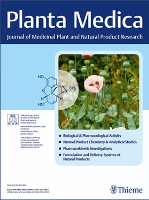
PLANTA MEDICA
Cultivating Knowledge in Plant-Based MedicinePLANTA MEDICA is a premier journal dedicated to advancing the field of medicinal plant research, published by Georg Thieme Verlag KG in Germany. With an ISSN of 0032-0943 and an E-ISSN of 1439-0221, this journal has been a cornerstone of scholarly communication since its inception in 1961. Recognized for its rigorous peer-review process, PLANTA MEDICA holds a notable reputation in the academic landscape, featuring a 2023 Q2 ranking in categories such as Analytical Chemistry and Pharmaceutical Science, along with respectable Q3 rankings in Drug Discovery and Molecular Medicine. The journal focuses on the synthesis, pharmacological, and biochemical assessment of phytochemicals, making it an essential resource for researchers, professionals, and students alike who are engaged in the exploration of complementary and alternative medicine. Although it does not offer open access options, its content is instrumental in identifying new therapeutic agents derived from plants, thereby underscoring its importance in drug discovery and holistic health research.

Applied Biological Research
Exploring Interdisciplinary Pathways in BiologyApplied Biological Research is a dynamic journal issued by the CENTRE ADVANCEMENT APPLIED SCIENCES, specializing in the interdisciplinary fields of biochemistry, genetics, and molecular biology. With its ISSN 0972-0979 and E-ISSN 0974-4517, this journal serves as a critical platform for the dissemination of peer-reviewed research that addresses pressing challenges and innovations within biological sciences. Although currently it does not adopt an Open Access model, it is dedicated to fostering academic discourse through rigorous publication practices. The journal's impact is underscored by its Scopus rankings, which place it in the 4th and 2nd percentiles in respective categories, emphasizing its emerging influence in the scientific community. Covering research from 2020 to 2024, Applied Biological Research is positioned as an essential read for researchers, professionals, and students seeking to stay at the forefront of biological research and application. Based in the beautiful region of Jammu & Kashmir, India, this journal is committed to advancing applied sciences through innovative research and outreach.
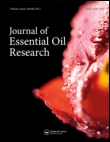
JOURNAL OF ESSENTIAL OIL RESEARCH
Enhancing Lives with Essential Oil InsightsThe Journal of Essential Oil Research, published by Taylor & Francis Inc, is a premier academic journal dedicated to the field of essential oils, encompassing their chemistry, applications, and therapeutic benefits. With an ISSN of 1041-2905 and an E-ISSN of 2163-8152, this journal has become a vital resource for researchers and professionals seeking to advance their knowledge in this niche yet significant area of study. Spanning from 1989 to 2024, the journal maintains a strong reputation, currently positioned in the Q2 quartile for Chemistry (miscellaneous) and achieving a Scopus rank of #116 out of 408, placing it within the 71st percentile of its category. Although not an open-access journal, it provides rigorous peer-reviewed articles that contribute valuable insights into the rapidly evolving field of essential oils. Its objectives include advancing scientific understanding and application of essential oils in various sectors, including food, health, and cosmetics, making it a crucial platform for scholars, researchers, and practitioners alike.

RUSSIAN JOURNAL OF BIOORGANIC CHEMISTRY
Pioneering Discoveries in Biochemistry and Organic ChemistryRussian Journal of Bioorganic Chemistry (ISSN: 1068-1620, E-ISSN: 1608-330X), published by MAIK Nauka/Interperiodica/Springer, serves as a vital resource for researchers and professionals in the fields of bioorganic chemistry, biochemistry, and organic chemistry. With a focus on the integration of organic chemistry principles with biological processes, this journal aims to disseminate significant findings and advancements from both theoretical and practical perspectives. Although currently not open access, the journal retains a dedication to high-quality, peer-reviewed content, contributing to its reputation within the academic community. The 2023 Scopus rankings position it within the Q4 category for both biochemistry and organic chemistry, indicating its critical niche within these disciplines amid a competitive landscape. Since its inception in 1996, the journal has continued to evolve, providing enriching insights and fostering collaborations among scholars and practitioners alike, with publication converging up to the year 2024. By exploring complex biomolecular interactions and the synthesis of biologically relevant compounds, the Russian Journal of Bioorganic Chemistry remains a significant platform for advancing knowledge and innovation in the life sciences.
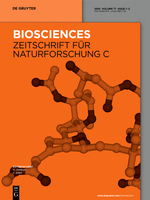
ZEITSCHRIFT FUR NATURFORSCHUNG SECTION C-A JOURNAL OF BIOSCIENCES
Exploring the Frontiers of BiosciencesZEITSCHRIFT FUR NATURFORSCHUNG SECTION C - A JOURNAL OF BIOSCIENCES, published by Walter de Gruyter GmbH, stands as a significant contribution to the field of biochemistry, genetics, and molecular biology. With an ISSN of 0939-5075 and an E-ISSN of 1865-7125, this esteemed journal has been disseminating critical research since its inception in 1973 and will continue to do so through 2024. As a recognized leader in its category, the journal holds a Q3 rank in the comprehensive field of biochemistry, genetics, and molecular biology, placing it in the 57th percentile according to Scopus rankings. While it operates under a traditional subscription model, this publication serves as a vital repository of high-quality, peer-reviewed articles that illuminate new discoveries and ongoing innovations within biosciences. Researchers, professionals, and students alike will find valuable insights and cutting-edge research within its pages, making it an essential resource for anyone serious about advancing their understanding in this dynamic field.